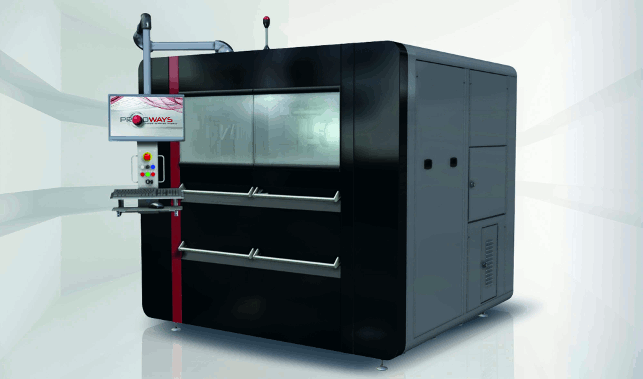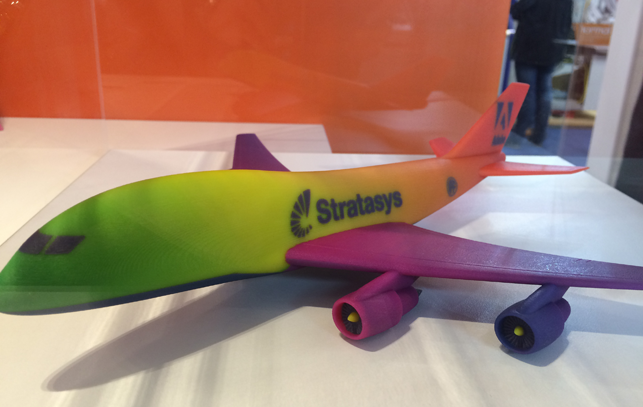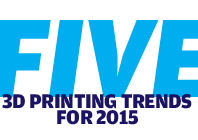1 Industrialisation is key
Speak to the big players in the 3D printing market and everything is about taking capacity and speed to the next level. This is no doubt caused in part by HP’s entry into the market, ruffling some feathers.

A relative newcomer, Prodways is set on producing large industrial DLP machines
The company’s promised Multi-Jet Fusion technology arrival in 2016 is aiming to be ready for industrial purpose.
Meanwhile Stratasys has reaffirmed its Fortus line-up as its keystone for real part manufacturing with a new high strength material, Ultem 1010. Already it is being used to print components for use in the world today – whether as custom jigs for manufacture, or hidden fixtures in things like aircraft.
Whilst 3D Systems, for all its dalliances with consumer 3D printing in the last few years, has come back harder into the manufacturing market. Everything in its marketing is about process, from prepping and postproduction, to the speed and materials. Its new colour plastics process is not attempting to be office friendly; it is a fully formed production line.
On the other hand, its latest metal printer is the size of a house, but comes with an add on powder prep facility and post-print booth to get new parts printing in the machine without any delay.
Most vendors are supersizing existing machines; cramming as much into the build area as possible. An elegant example is that of relative newcomer Prodways, which is producing real parts for products like hearing aids.
It has fleshed out its Digital Light Processing (DLP) technology to create a line-up of new large format printers, with the largest offering a build area of 840 x 660 x 550mm.
Using high-power UVA LEDs, two DLP light engines moves over the build area, allowing high resolution across the large build area.
Capacity is one thing, but materials are still a sticking point, which is why the Arburg Freeformer continues to draw a lot of interest.
Producing parts using the cheap plastic granules readily available for moulding products, manufacturers get the real thing and not an expensive proxy.
2 Colour creeeping in
Since Stratasys made a splash earlier this year with its colour technology we’ve seen interest from customers grow.
The Stratasys colour technology is now available across its Connex range, down to the office friendly Objet260, and is sure to permeate down to more customers in 2015.
These will be those wanting realistic prototypes, and despite the initial limited colour palette offerings, the introduction of Adobe’s Photoshop software has expanded its abilities to offer all colours, with seamless blending.

The Stratasys Connex colour technology has been boosted by Adobe’s Photoshop software
Despite this, 3D Systems still has the most established colour process out there. The ZCorp powder-based technology it acquired in 2011 is faster but lacks the slick finish, but that hasn’t stopped the company developing its own methods.
3D Systems’ own multi-material SLA printers can mix two colours, but rather than trying to cram more technology into a single print head, it has made the print bed the moving entity.
Still in development, its Continuous High Speed Fabrication Grade Printing technology is a factory machine. A giant ‘slot-car track’ directs the print beds around the track, stopping under different print heads for different materials to be applied.
The finished test parts, such as phone cases, look like they have photographs screen printed on, but in reality, the colours were part of the actual product structure.
While Stratasys has focussed on perfecting the prototyping process, 3D Systems has shot straight at manufacturing.
Away from the main two, don’t forget Mcor, which is slowly picking up interest from the education markets by giving away free consumables with its printers.
FDM is cheap, but with a few hundred school kids wanting to print more regularly, costs will soon mount up.
HP’s technology won’t launch till 2016, yet it is fitting to note that it deems colour to be a requirement of its process.
In the time between, expect a footrace from vendors looking to lead the colour revolution.
3 The new small
Desktops, consumer models, sausage makers, whatever you want to call them, small printers have been pushed back from focus recently.
The demand isn’t nearly as high as expected, and the cheaper price point FDMs aren’t too clever for the professional users who don’t want to spend their time tinkering around.
Instead, something brilliant is happening: the smaller machine market is booming with new high definition machines as start-ups and companies in the Far East enter the market.
More competition means cheaper prices, with small SLA machines – predominantly all using variations on DLP technology – coming forward.

3D Systems’ ProJet 1200 now has five new materials, including two colours for jewellery prototypes (left), and a new castable (right)
The revolution that started with FormLabs Form 1 now has competition from Roland’s MonoFab, 3D Systems’ ProJet 1200 with new materials, and the open source Autodesk Ember.
Other entries to the market like Kevvox’s new dinky desktop offer less established alternatives, while more than a couple of people we have spoken to are waiting for the DWS XFab to launch in the New Year.
The versatility to create cast metal parts using these machines for industries such as jewellery is a big draw.
While 3D Systems and FormLabs have produced new castable materials for their printers, there are still sharper details to be found in true wax printers like the new SolidScape Max2.
4 Metal making big noise
It might be the least polished of all the technologies, but metals 3D printing is the one everyone wants to know more about.
The machines and their productivity are growing in size, with not many bigger than the 3D Systems ProX 400, developing the technology from its acquisition of Phenix.

The ProX 400 metal printer has add-on units designed by 3D Systems to speed up the metals printing process
A 500 x 500 x 500 mm print volume, twin laser system, and productivity-enhancing modular set up ensured it had lots of attention at its launch.
Drawing just as much attention are new machines from Renishaw, EOS and the current crop from Concept Laser and Arcam.
Yet the machine that still has our jaws on the floor is DMG Mori’s Lasertec 65.
Using a nozzle to directly jet powder at the target area before welding it with a 2kw diode laser, it is claimed to be ten times faster than flatbed methods.
All 3D printed metals need machining to finish, so DMG built a 5-axis mill into its printer build area.
The flexibility to change between laser and milling through the process allows the machining of sections that are not normally reachable within a standard 3D printed part.
Yet the most restrictive point about all these metal printing technologies is not buying a new machine (although they’re anything but cheap), but running it effectively.
Training for using such machines properly and learning best practices are the stumbling block to wider adoption.
When you’re playing with lasers, powdered metals and pressurised gases, the rewards are big, but the risk of costly build fails and more dangerous accidents happening are considerably bigger.
As the machines become more commonplace we expect to see this improve quickly over the next year.
A relatively safer bet is metals casting from 3D printed moulds. ExOne and Voxeljet are still the leading proponents of the technology on the large scale, while small precision parts can still turn to castable plastics or the ever-present desktop Solidscape wax printer.
5 An open new world
Up to this point, everything for 3D printers has come thorough the machine vendors themselves – the hardware, the software and the materials.
However, the industry has attracted a lot of interest and now much bigger technology companies are stepping in.
HP’s new Multi-Jet Fusion technology might be over a year away from market, but it has opened the debate on the principles of open source development, echoed by its partnership with Autodesk.
Autodesk’s own Ember 3D printer is deemed open source; the plans will be made available online, people are being encouraged to develop their own custom upgrades and their own materials, to build something new.
The Spark software will cannily remain Autodesk’s property, but they have a point about needing to drive development forward at a pace faster than the two big rival vendors can manage alone.
Speaking with Stratasys and 3D Systems, both remain adamant that materials and machine must remain in development harmony together for the best printing results.
Yet as the market continues to grow, the increasing profits will no doubt attract the industrial plastics and materials development agencies.
By improving 3D printing’s industrial credentials and refusing to open up to a world of external development, the current vendors might be looking at more competition in the future.
Finally, there are a couple of new 3D printing technologies due to surface at the beginning of the coming year.
From the previews we’ve had already, they’re nothing short of remarkable and are already changing the way major vendors are approaching the market.
This alone means 2015 is going to be a very interesting year for the technology.
We pick out five key trends for the coming year
Default






